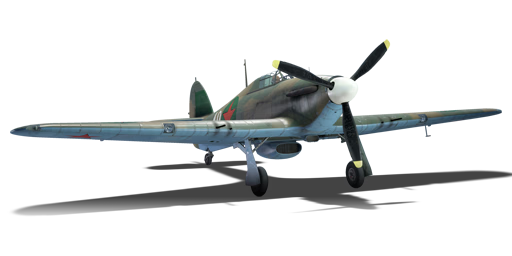

Aviation
▂Hurricane Mk IIB
II
Rank
AB
3.0
RB
3.0
SB
3.0
Battle rating
USSR
Research country
Fighter
Main role
700

Purchase

Premium vehicle
Status
General information
The Hurricane Mk IIB (USSR) is a premium Soviet fighter. It was introduced in Update 1.51 "Cold Steel".
A modified Lend-Lease Hurricane, this Soviet take on the famous British fighter boasts enhanced firepower. Twin 20 mm ShVAK cannons and 12.7 mm Berezin UB machine guns give this machine a potent bite and the Hurricane's good turning capabilities make it a powerful opponent in frantic dogfights. However the Hurricane chassis has not quite kept up with its contemporaries and getting into a position to use its strengths can be tricky. Still, for those who want a rugged turnfighter with great firepower, the Hurricane does the job.
Camouflages
Flight performance
Max speed
at 5,182 m
565524593541 km/h
Rate of Climb
13918.69 m/s
Turn time
1516.514.115.9 s
Max altitude
11,500 m
Takeoff Run
359 m
Landing
flaps
flaps
Take-off
flaps
flaps
Combat
flaps
flaps
Air
brake
brake
General characteristics
Crew
1 person
Engine
Length
9.6 m
Wingspan
12.2 m
Wing Loading
132 kg/m²
Weight:
Base weight
2.852.942.782.93 t
Fuel in main tanks
0.32 t (1h 4m)
Limits:
Max Speed Limit (IAS)
660 km/h
Mach Number Limit
0.79 M
G limit
≈ -7/12 G
Flap Speed Limit (IAS)
L / T / C
202 / 247 / 268 km/h
Gear Speed Limit (IAS)
320 km/h
Offensive armament
2 × 20 mm ShVAK cannon
Ammunition
240 rounds
Fire rate
800 shots/min
One-second Burst Mass
1.29 kg
| Belt | Belt filling | Armor penetration (mm) at a distance: | |||||
|---|---|---|---|---|---|---|---|
| 10 m | 100 m | 500 m | 1000 m | 1500 m | 2000 m | ||
| FI-T/AP-I | 28 | 24 | 14 | 7 | 4 | 2 | |
| FI-T/HEF/AP-I/FI-T | 28 | 24 | 14 | 7 | 4 | 2 | |
| HEF/FI-T/AP-I | 28 | 24 | 14 | 7 | 4 | 2 | |
| FI-T | 4 | 4 | 4 | 4 | 4 | 4 | |
| AP-I/FI-T/AP-I/AP-I | 28 | 24 | 14 | 7 | 4 | 2 | |
| AP-I/HEF/HEF/FI | 28 | 24 | 14 | 7 | 4 | 2 | |
2 × 12.7 mm Berezin UBK machine gun
Ammunition
240 rounds
Fire rate
1,026 shots/min
One-second Burst Mass
0.82 kg
| Belt | Belt filling | Armor penetration (mm) at a distance: | |||||
|---|---|---|---|---|---|---|---|
| 10 m | 100 m | 500 m | 1000 m | 1500 m | 2000 m | ||
| T/AP/AP/IAI | 32 | 30 | 22 | 15 | 11 | 7 | |
| AP-I/API-T/IAI/IAI | 29 | 27 | 20 | 13 | 9 | 6 | |
| API-T/AP-I/AP-I/IAI | 29 | 27 | 20 | 13 | 9 | 6 | |
| AP-I(c)/AP-I/AP-I/API-T/IAI | 34 | 32 | 24 | 17 | 12 | 8 | |
| API-T | 29 | 27 | 20 | 13 | 9 | 6 | |
| AP-I/AP-I/IAI | 29 | 27 | 20 | 14 | 9 | 6 | |
Suspended armament
Setup 1
6 × ROS-82 rockets
Setup 2
6 × RBS-82 rockets
Economy
Repair cost
AB
879 

RB
1,580 

SB
674 

Crew training
2,300 

Experts
15,000 

Aces
125 

Research Aces
320,000 

Reward multiplier
AB / RB / SB
 2 x (35 / 80 / 125) %
2 x (35 / 80 / 125) % 
 2 x 112 %
2 x 112 % 

Premium vehicle
All modifications are unlocked
Flight performance | |
|---|---|
Survivability |
|---|
Weaponry | |
|---|---|
Rating by players
You must play more than 3 battles for the last week and more than 10 battles in a vehicle to rate it.
Like:
15
Flight performance:
Not enough ratings
Survivability:
Not enough ratings
Aerial combat:
Not enough ratings
Ground attack:
Not enough ratings
Balance:
Not enough ratings
Tips & Tricks
This space is currently empty
Do you know any interesting vehicle features?
Loading...
No articles about this vehicle yet
Become the first author and get rewards!
Write a guide, tell about interesting historical facts, make a tutorial or simply an interesting post.
No more content